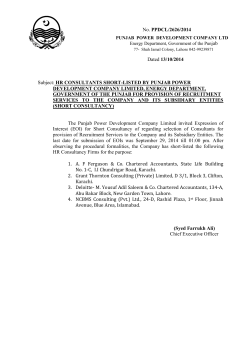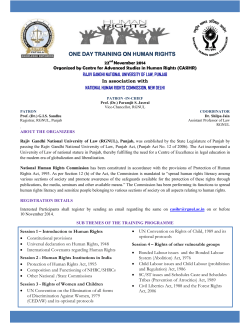
SELENOPORTAX VEXILLARIU
Geol. Bull. Punjab Univ. Vol. 40-41, 2005-6, pp 53-55 53 FOSSIL MOLARS OF SELENOPORTAX VEXILLARIUS BY MUHAMMAD AKBAR KHAN, MUHAMMAD AKHTAR , MEHBOOB IQBAL Department of Zoology, Quid-e-Azam Campus, University of the Punjab, Lahore 54590, Pakistan Email: akbaar111@yahoo.ca MUHAMMAD ANWAR QURESHI Geology Department, University of Azad Jammu & Kashmir, Muzaffrabad, Pakistan AND UMAR FAROOQ Executive District Officer Education, Khushab (Johrabad) University, Pakistan Abstract: Two upper second and third molars of Selenoportax vexillarius are collected from Hasnot and described in this paper. The molars are ever-preserved fossil specimens of S. vexillarius found from the Middle Siwaliks of Pakistan. All the morphological characters of the fossilized cheek teeth are excellently preserved and not any part of the specimens is damaged. INTRODUCTION Type Species: Selenoportax vexillarius Pilgrim, 1937. The earliest known boselaphines if Eotragus be excluded may be in Pakistan in the middle Miocene (17.6 million years ago; Solounias et al., 1995; Gentry, 1999). In Africa Kipsigicerus is of middle Miocene age (Thomas, 1984). In Europe boselaphines do not appear until later in the middle Miocene, and in China they appear only in the late Miocene. The Eurasian ones, surprisingly, have lower crowned teeth and longer premolars row than Kipsigicerus (Gentry, 2000). Included Species: Selenoportax vexillarius Pilgrim, 1937; Selenoportax lydekkeri Pilgrim, 1937; Selenoportax tatrotensis Akhtar, 1992; Selenoportax dhokpathanensis Akhtar, 1992. Boselaphines are known abundantly from the Middle Siwaliks but found scarcely from the Lower and Upper Siwaliks of Pakistan. Most of the boselaphine specimens are collected from the Dhok Pathan village, a type locality of the Middle Siwaliks and from the Hasnot, a late Miocene locality of the Siwaliks. The studied specimen is collected from the Hasnot, 5-7 million years old in age and situated at 70 km west of the Jhelum, a city of the Punjab in the Potwar Plateau of northern Pakistan. SYSTEMATIC PALEONTOLOGY Tribe Boselaphini Simpson, 1945 Genus Selenoportax Pilgrim, 1937 Distribution: Middle to Upper Siwaliks. Selenoportax vexillarius Pilgrim, 1937 Type Specimen: A skull lacking maxilla and dentition and most of the basicranium (AMNH 19748). Referred Specimen: A broken maxilla having second and third molars (PUPC 06/14). Locality: Hasnot, Jhelum district, the Punjab province, Pakistan. Stratigraphic Level: Middle Siwaliks. Diagnosis: Cheek teeth large and strongly hypsodont, enamel very rugose. Upper molars quadrate with strong and divergent styles near the neck of crown, ribs quite large, entostyle strongly developed. Fossettes without indentations and simple in outline, transverse anterior goat folds poorly developed at front of lower molars. 54 Khan et al. DESCRIPTION Two cheek teeth belonging to upper dentition are described here. PUPC 06/14 (Fig. 1a, b and c) is extremely hypsodont and narrow crowned. The right upper second molar (M2) is a well preserved molar and all the principal cones are preserved up to the apex. The paracone and protocone are well developed anteriorly and pointed in the middle with two running cristae. The metacone and hypocone are present posteriorly with their well developed styles. The anterior and posterior median ribs are prominent in the molar. The enamel is moderately thick and rugose. The rugosity is more distinct on the buccal side than on the lingual side of the tooth. The entostyle is present in the transverse valley between the protocone and the hypocone and oval in shape owing to the early wear. The parastyle is very strong and prominent. The mesostyle and the metastyle are moderately developed and the anterior median rib is more prominent than the posterior rib. The fossettes are well defined and wide. The third right upper molar of PUPC 06/14 is in an excellent state of preservation and in an early stage of wear. The enamel is finely rugose and the rugosity is more evident on the lingual side than the buccal side. The entostyle is strongly developed and looks like a pillar present in the transverse valley of the molar. The principal cones are well developed and the buccal cusps are higher than the lingual ones, which at this stage of wear are not attached to each other at the transverse valley. The protocone is V-shaped and praeprotocrista is slightly longer than postprotocrista. The prae-and postparacristae are equal in length. The prae- and posthypocristae are more crescentic than the prae- and postmetacristae of the molars. The styles and median ribs are well developed. The fossettes are wide and no spur of the enamel seems to project into these fossettes. Fig.-1: S. vexillarius (PUPC 06/14): A) Crown view, B) Lingual view C) Buccal view. Table-1 Comparative measurements of the cheek teeth of Selenoportax vexillarius in mm (millimeters). * The studied specimens. Number PUPC 06/14* PUPC 00/53 PUPC 96/39 PUPC 01/23 PUPC 87/199 AMNH 19844 PMNH 87/19 Nature right molar right molar right molar right molar left molar left molar right molar a maxillary part of the skull having right P3-M3 and left P4-M3 Position 2 M M3 M2 M2 M2 M3 M2 P3 P4 M1 M2 M3 P Length Width W/L ratio 27.0 32.0 27.5 26.0 23.5 25.0 25.7 19.5 19 24.2 29 28.7 23.0 26.0 18.5 19.0 19.5 21.2 24.0 16.5 17 21.5 21 18 0.85 0.81 0.67 0.73 0.82 0.84 0.93 0.84 0.89 0.88 0.72 0.62 55 DISCUSSION Selenoportax and Pachyportax are known from the late Miocene of the Siwaliks (Khan et al., 2006). The Selenoportax is a moderate to large sized Boselaphini, whereas Pachyportax is a gigantic sized form. The PUPC 06/14 is large enough to exclude it to the small Siwalik bovids. The general contour of the studied specimen, the rugosity of the enamel, the strong entostyles, the prominent median ribs, the strong and divergent styles evidently prove the specimen inclusion in the genus Selenoportax (Akhtar, 1992, 1995, 1996). Pilgrim (1937) based this genus on a collection from the various Siwalik localities of Pakistan and India. Pilgrim referred all the collected specimens to the genus Selenoportax and added two species in it, S. vexillarius and S. lydekkeri. The dimensions (Table 1) and the morphology of the studied material reveal all the features of the species S. vexillarius cited by Pilgrim in 1937. PUPC 06/14 present the same morphological features of the type specimen AMNH 19844 (Pilgrim, 1937). The specimen is an extremely hypsodont and narrow crowned tooth as indicated by its measurements. The molars show fine enamel corrugacy, which is relatively more prominent on the lingual side than on the buccal side. However, the wrinkles are more conspicuous on the buccal side than on the lingual side. REFERENCES Akhtar, M., 1992. Taxonomy and Distribution of the Siwalik Bovids. Ph. D. Thesis, Punjab Univ., Lahore, Pakistan, 1-371. Akhtar, M., 1995. Pachyportax giganteus, new species (Mammalia, Artiodactyla, Bovidae) from the Dhok Pathan, district Chakwal, Punjab, Pakistan. Pak. Jour. Zool., 27(4): 337-340. Akhtar, M., 1996. A new species of the genus Selenoportax (Mammalia, Artiodactyla, Bovidae) from Dhok Pathan, district Chakwal, Punjab, Pakistan. Proc. Pak. Cong. Zool., 16: 91-96. Gentry, A. W., 1999. Fossil Pecorans from the Baynunah Formation, Emirate of Abu Dhabi, United Arab Emirates. Chap. 22 in Abu Dhabi pecorans, Yale University Press, New Haven, 290-316. Gentry, A. W., 2000. The Ruminant Radiation, in E. S. Vrba and G. B. Schaller (eds.), Antelopes, deer and relatives: fossil record, behavioral ecology, systematics and conservation. Yale University Press, New Haven, 11-25. Khan, M. A., Khan, A. M., Farooq, U. and Akhtar, M., 2006. Selenoportax vexillarius (Mammalia, Boselaphini, Bovidae) from the Siwaliks. Pak. Jour. Zool., 38 (4): 321-326. Pilgrim, G. E., 1937. Siwalik antelopes and oxen in the American Museum of Natural History. Bull. Amer. Mus. Nat. Hist., 72: 729-874. Solounias, N., Barry, J. C., Bernor, R. L., Lindsay, E. H. & Raza, S. M., 1995. The Oldest Bovid from the Siwaliks, Pakistan. Jour. Vert. Paleont., 15 (4): 806-814. Thomas, H., 1984. Un nouveau bovide dans les couches a Hominoidea du Nagri (Siwaliks moyens, Miocene superieur), Plateau du Potwar, Pakistan: Elachistoceras khauristanensis, gen. nov. sp. nov. (Bovidae, Artiodactyla, Mammalia) Bull. Soc. Geol. France, 19: 375-383.
© Copyright 2025














